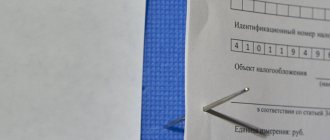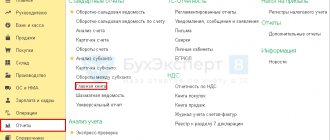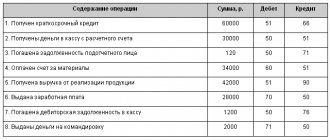Online accounting for individual entrepreneurs on OSNO!
The service will help you fill out 3-NDFL and determine what is considered income/expense.
Try for free
For individual entrepreneurs, accounting and reporting depends on the chosen taxation system. In this article we will look at maintaining KUDiR IP on OSNO. KUDiR is an accounting book, one of the main elements of control over income and expenses. An individual entrepreneur is obliged to maintain it. The book is filled out strictly in accordance with the requirements of the current legislation of the Russian Federation.
Why do you need KUDiR IP?
KUDiR is recognized as a tax accounting register, although it combines accounting and tax accounting. The document reflects the following data:
- information about fixed assets and depreciation;
- calculation of wages and taxation;
- utilities and other expenses;
- taxation of business transactions with identification of the difference, which is ultimately subject to personal income tax.
KUDiR IP is needed to form the tax base for personal income tax (NDFL) for the tax period, which is considered a calendar year. Individual entrepreneurs pay 13% of the calculated difference between income and expenses to the budget.
If at the end of the tax period the financial result is negative, i.e. There is a loss, then no tax is paid. Also, the loss is not carried forward to a future tax period and is not covered by the profits of subsequent years.
Legal basis
The procedure for calculating and paying personal income tax by individual entrepreneurs (hereinafter referred to as individual entrepreneurs) is regulated by the provisions of Chapter 23 of the Tax Code of the Russian Federation.
In accordance with paragraph 1 of Art. 210 of the Tax Code of the Russian Federation, when determining the tax base, all income of the taxpayer received by him, both in cash and in kind, or the right to dispose of which he has acquired, as well as income in the form of material benefits, determined in accordance with Art. 212 of the Tax Code of the Russian Federation, and if any deductions are made from the taxpayer’s income by order, by decision of a court or other authorities, such deductions do not reduce the tax base.
According to paragraph 2 of Art. 54 of the Tax Code of the Russian Federation, individual entrepreneurs calculate the tax base at the end of each tax period on the basis of accounting data for income and expenses and business transactions in the manner determined by the Ministry of Finance of Russia.
This procedure was established by order of the Ministry of Finance of Russia N 86n, Ministry of Taxes of the Russian Federation dated August 13, 2002 N BG-3-04/430 “On approval of the Procedure for accounting for income and expenses and business transactions for individual entrepreneurs” (hereinafter referred to as the Accounting Procedure).
Paragraph 2 of clause 2 of the Accounting Procedure determines that accounting data for income and expenses and business transactions are used to calculate the tax base for personal income tax (hereinafter referred to as personal income tax) paid by individual entrepreneurs on the basis of Chapter 23 of the Tax Code of the Russian Federation.
In accordance with the previously valid clause 13 of the Accounting Procedure, income and expenses had to be reflected in the Accounting Book on a cash basis, that is, after the actual receipt of income and the expenditure. This paragraph of the Accounting Procedure by decision of the Supreme Arbitration Court of the Russian Federation dated October 8, 2010 N VAS-9939/10 was declared invalid.
In its decision, the Supreme Arbitration Court indicated that the provisions of the Tax Code of the Russian Federation enshrine the right of entrepreneurs to reduce taxable income by the amount of actually incurred and documented expenses associated with its receipt. The composition of costs is determined in a manner similar to that established for calculating income tax. The above norm refers to the provisions of Chapter 25 “Income Tax” of the Tax Code of the Russian Federation. This chapter, establishing the procedure for recognizing income and expenses, establishes two methods - accrual and cash. Moreover, the choice of any of them is the right of the organization, subject to its compliance with certain requirements. Thus, the establishment in clause 13 of the Accounting Procedure of the provision on the mandatory use of individual entrepreneurs exclusively by the cash method of accounting for income and expenses does not correspond to clause 1 of Art. 273 Tax Code of the Russian Federation.
Clause 14 of the Accounting Procedure states that the Accounting Book (Section I of the Accounting Book) reflects all income received by individual entrepreneurs from business activities without reducing them by the tax deductions provided for by the tax legislation of the Russian Federation.
Income includes all receipts from the sale of goods, performance of work and provision of services, as well as the value of property received free of charge.
The cost of goods sold, work performed and services rendered is reflected taking into account the actual costs of their acquisition, implementation, provision and sale.
Amounts received as a result of the sale of property used in the process of carrying out business activities are included in the income of the tax period in which this income was actually received.
Income from the sale of fixed assets and intangible assets is determined as the difference between the sales price and their residual value.
Thus, in the current version of the Accounting Procedure, the definition of income using the cash method is established only for income from the sale of property.
At the same time, in accordance with paragraph 1 of Art. 223 of the Tax Code of the Russian Federation, the date of actual receipt of income is the day:
1) payment of income, including transfer of income to the taxpayer’s bank accounts or, on his behalf, to the accounts of third parties - when receiving income in cash;
2) transfer of income in kind - when receiving income in kind;
3) acquisition of goods (work, services), acquisition of securities - upon receipt of income in the form of material benefits. If payment for acquired securities is made after the transfer of ownership of these securities to the taxpayer, the date of actual receipt of income is determined as the day the corresponding payment is made to pay for the cost of the acquired securities;
4) offset of counter similar claims;
5) writing off bad debt from the organization’s balance sheet in accordance with the established procedure;
6) the last day of the month in which the advance report is approved after the employee returns from a business trip;
7) the last day of each month during the period for which borrowed (credit) funds were provided, upon receipt of income in the form of material benefits obtained from savings on interest when receiving borrowed (credit) funds.
Maintaining KUDiR on OSNO
KUDiR on OSNO is formed from the beginning of the tax period. The accounting book is kept either by the entrepreneur himself or by an accounting employee; it is kept for 4 years. Individual entrepreneurs provide an accounting book along with 3-NDFL reporting. Thus, KUDiR is submitted to the tax office at the place of registration until April 30.
The magazine has a unified form. However, the entrepreneur has the right to independently create the form of the document. Coordinate all changes with the tax authority. If the developed version of the register is not approved, the tax office may not count the bookkeeping.
KUDiR is maintained in paper or electronic form. The book, issued in electronic form, is printed at the end of the calendar year. It is also laced, numbered and signed. Do all this with the book, which was kept in paper form. Previously, KUDiR had to be certified by the tax office, and the paper book was certified before filling out, and the electronic book after printing. Now the law does not require a certification procedure.
Contents of KUDiR
KUDiR reflects information about the individual entrepreneur, the contents of the document, as well as six sections. The type of tables and sections of the book depends on the type of activity of the organization. The document reflects all income and expense procedures. Here are the requirements for the responsible person when maintaining the book:
- checking the receipt of cash and non-cash funds;
- control over payment to the supplier for each type of product sold during the work shift;
- correct write-off of product costs as expenses, which is carried out using the FIFO method or the average unit cost.
Entries in the accounting book are made continuously on the basis of primary documents at the time of the transaction, i.e. on a cash basis. Business transactions are reflected in chronological order in ruble equivalent. For transactions in foreign currency, their value is translated at the rate of the Central Bank of the Russian Federation into rubles on the day of receipt or disposal of funds.
If errors occur in KUDiR OSNO, they are corrected: the incorrect information is carefully crossed out, substantiated by the correct entry, certified with the signature of the individual entrepreneur and the date of the correction is indicated. The tax office may not accept KUDiR when submitting reports due to serious filling errors.
Common IP errors on OSNO when filling out KUDiR
Error 1. The data in KUDiR should be corrected correctly, using the norms of the established Procedure.
You should know that all corrections in the accounting book are made only manually. Therefore, if you need to correct an error or make changes to the KUDiR, all necessary entries should be made by hand. As established, the date of editing must be indicated next to it and everything must be certified with the signature of the individual entrepreneur. It is prohibited to use corrective means, paint over, or “mask” errors, entries, letters, or words.
Error 2. You can make changes to the primary accounting documentation, but only by agreeing on these corrections directly with the originator of the document. Moreover, the amendment made is recognized as valid if it is certified by the signature of this compiler indicating the date of its entry.
The exception is bank and cash documents - changes are not allowed in them.
Procedure for filling out KUDiR IP OSNO
Each section of KUDiR IP OSNO includes many subparagraphs, the completion of which is mandatory.
The title page includes information about the individual entrepreneur: full name, INN, address, information about the tax authority at the place of registration of the individual entrepreneur, data from the registration certificate, bank details, as well as the individual entrepreneur’s signature, date and other data.
Section 1 displays all income that was actually received in the tax period, including advances, as well as expenses actually incurred in this period. This reflects raw materials, semi-finished products and other inventory items acquired by the individual entrepreneur for subsequent financial gain. Moreover, costs during the manufacture of products are written off as expenses only in relation to the products sold. They can also be written off according to the standards established by the legislation of the Russian Federation.
Sections 2 - 4 include information on depreciation of fixed assets, low-value wear-and-tear items (IBP) and intangible assets. The initial cost of fixed assets and intangible assets is determined based on the cost of acquisition, delivery costs and putting the property into operation. Depreciation is written off as expenses only in the amount accrued for the tax period. Depreciation deductions are made only in relation to the individual entrepreneur’s own property, i.e. which was purchased for a fee. Income from the sale of fixed assets and intangible assets is the difference between the sale price of the property and its residual value.
Section 5 covers payroll and taxes. The table in this section resembles a payroll sheet; it is generated for each month. The table displays the following information:
- the amount of calculated and paid wages;
- incentive and compensation payments;
- the cost of goods that are issued as remuneration in kind;
- payments under copyright and civil law contracts;
- other payments;
- calculated personal income tax;
- other deductions;
- date of payment;
- signature on receipt.
Section 6 calculates the tax base for personal income tax, which is formed based on the results of the calendar year. On its basis, 3-NDFL reporting is completed.
Section V. Calculation of wages and taxes
Table 5 is filled out for each month separately when paying wages or payments under contracts. The table includes:
- Amounts of accrued and paid wages.
- Compensation and incentive payments.
- The cost of goods issued in kind.
- Payments under civil law contracts and copyright agreements.
- Other payments in accordance with the concluded agreement.
Table 5 is actually a payroll statement, as it includes calculated income tax, other deductions, payment date and signature on receipt.
Responsibility for violation of the procedure for maintaining KUDIR
Gross violations of the requirements for accounting for income, expenses, as well as the object of taxation are regulated by Article 120 of the Tax Code of the Russian Federation. The following types of fines have been established: 10,000 rubles - a fine for a gross violation committed during one tax period; 30,000 rubles - a fine for the same act committed during more than one tax period; 20% of the amount of unpaid tax, but not less than 40,000 rubles - a fine for a violation that resulted in an underestimation of the tax base.
Author of the article: Ekaterina Moguchaya
Work in the cloud service for small businesses Kontur.Accounting: there is simple accounting, payroll, taxes and reporting via the Internet. Work for free for the first 14 days and learn about all the capabilities of the service.
Procedure for accounting for individual entrepreneur expenses
There are 3 conditions under which an individual entrepreneur can take into account expenses to calculate personal income tax. Expenses should be:
- paid;
- used in the professional activities of individual entrepreneurs;
- confirmed by documents (invoices, acts, invoices).
If for some reason an entrepreneur cannot provide documentary evidence of his expenses, then in this case he can take advantage of a professional deduction in the amount of 20% of the amount of income received.
However, it is impossible to take into account both documented expenses and the 20% standard.
IP expenses have recognition criteria, which are reflected in the Procedure for accounting for income and expenses and business transactions for individual entrepreneurs adopted by the Ministry of Finance of Russia (order No. 86n dated August 13, 2002):
1. There is a connection between the income and expenses of an individual entrepreneur.
2. Expenses for the purchase of raw materials, materials, goods are recognized for taxation after their actual payment. The moment of their accounting is not related to the date of receipt of income from the sale of goods (work, services), for the production (fulfillment, provision) of which these expenses were incurred (see decision of the Supreme Court of the Russian Federation of June 19, 2017 No. AKPI17-283, decision of the Supreme Arbitration Court of the Russian Federation No. VAS-9939/10).
3. Amounts of accrued depreciation can be included in professional deductions only for property and results of intellectual activity owned by the individual entrepreneur and used by him in carrying out business activities. Even if the property is jointly owned by spouses, one of whom is an individual entrepreneur, accrued depreciation can also be used to reduce the income of an individual entrepreneur (letter of the Ministry of Finance of Russia dated December 7, 2012 No. 03-04-05/3-1377).
4. If the work is seasonal, it is also necessary to observe the principle of linking income received and expenses incurred.
An individual entrepreneur is exempt from the obligation to maintain accounting records, however, when accounting for expenses for remuneration of employees, an individual entrepreneur can also include in professional deductions the costs of remunerating an accountant, since, according to clause 23 of the procedure for accounting for income and expenses, an individual entrepreneur can reduce his income by any accruals by wages for employees who work under employment contracts.
How can an individual entrepreneur applying the general tax regime take into account the costs of acquiring fixed assets? The answer to this question was given by 1st Class Advisor to the State Civil Service of the Russian Federation D. A. Morozov. Get free trial access to the ConsultantPlus system and get acquainted with the official’s point of view.
If an individual entrepreneur applies several tax regimes, for example OSNO and UTII, then he must keep separate records of income and expenses for these regimes. An individual entrepreneur can include as expenses for calculating personal income tax only documented expenses associated with the general taxation regime.
Read about the specifics of paying personal income tax when applying tax regimes available to individual entrepreneurs in the article “Should individual entrepreneurs pay personal income tax (cases and nuances)?”








